|
July 24, 2022
Dear Neighbors and Friends,
I hope that you and your loved ones are doing well, staying healthy, and looking out for your neighbors and friends during this past week.
As I know you know, we’re heading into a week of elevated heat, with temperatures approaching or surpassing 100 degrees. Portland and Multnomah County are preparing a number of safety measures for those who need relief from the heat, including cooling centers, safe spaces, and free Tri-Met transportation for those who need it. You can read more about these resources here.
In this week’s newsletter I’ll be talking about last week’s site visits by the legislative task force focusing on improving access and retention for “non-traditional” students at Oregon’s colleges and universities. This was the last of the visits with students and communities around the state; now it's time for us to begin work on finding improvements and solving the During this coming week I’ll also be leading or participating in work groups on large-scale chicken operations, small-scale renewable energy projects, the use of solitary confinement in our prisons, and prison health care. More on those will be coming.
On the COVID front, you’ll see that the current Omicron phase of the pandemic continues to be in a holding pattern. We’re beginning to see slow declines in nearly all the COVID metrics.
You’ll also see that this week’s wastewater monitoring for the state shows continued improvement: the amount of virus in all our cities has plateaued or gone down. The number of counties at High Risk has also gone down a little (but only one Oregon county is now at Low Risk).
According to the most recent OHSU forecast report, we should be seeing slowly declining infection and hospitalization numbers over the next couple of months.
More on all this in the various graphs, reports, and links in this week’s newsletter.
Finally, you’ll see below that we have passed another of those sad COVID milestones: 8000 Oregonians have now died of COVID-related illness. Every one of them is a difficult, painful loss. Many thanks to those who cared for them in their final hours and days.
Until next time, please stay healthy and safe. And let me know if you have any questions or thoughts about anything in this week’s newsletter.
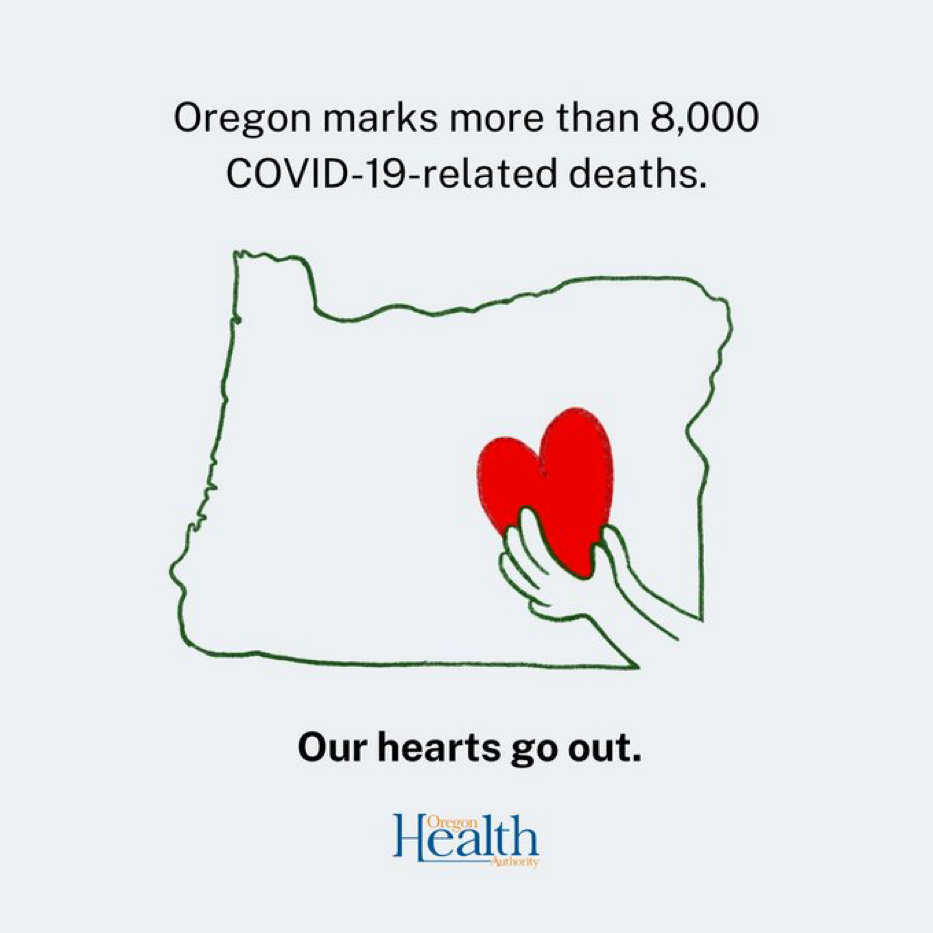
Higher Ed Task Force Heads South for a Final Visit
I’ve written before about the Joint Task Force on Student Success for Underrepresented Students in Higher Education. The Task Force is the result of HB 2590 (2021) designed to address the challenge of getting more Oregonians into post-secondary education and training and supporting them to successful completion. It focuses in particular on those students who are first in their families to attend college, students who are from low-income families, students of color, students from rural communities, students with family responsibilities, LGBTQ students—those who have faced particular challenges in entry and retention.
Over the last few decades we’ve seen less and less investment in higher education from Congress and from most of the states. Oregon is no exception. More and more of the cost of going to college or trade schools has shifted from public support to tuition; from grants, scholarships, and Work-Study opportunities to loans. In order to pursue higher ed, students and their families are having to assume increasingly high debt loads. As a result, many Oregonians are giving up on going to college, at a time when we are running dangerously short of teachers, counselors, engineers, healthcare workers, technicians, and other professionals. It’s crucial that we get more people to begin (or resume) education and training
Along with monthly zoom meetings, the task force has been visiting campuses all over the state, meeting with students, community leaders, faculty, and staff in order to hear firsthand about the particular challenges students are experiencing these days. Last week we made our final site visits: to Southern Oregon University in Ashland and Rogue Community College in White City.
We again heard about the great success that “first-gen” students can experience when their schools are able to provide them with “wraparound” programs that support them and guide them—but current funding levels only allow them to be provided to a fortunate few.
We heard about the big challenges with our Oregon Promise program—which provides the promise of free tuition—but only to community college (not university) students and only to those young people coming directly out of high school. The many, many Oregonians who are not ready or able to go directly to higher education but who need to are left out. During our discussions with Rogue Community College students, every single student met that description.
We also heard another recurring theme of these visits: the lack of affordable housing for students and their families. Many of us in the metro region think that lack of affordable housing is an urban problem, and we do hear about it most from urban legislators. But in reality, residents of nearly all of the state’s rural areas are facing equal challenges finding places to rent. The high cost of room and board is forcing students to work two or three jobs while attending school, and that’s when they can even find housing for themselves and their families. This is clearly a problem that we need to tackle.
If you’re interested in learning more about the visits and meetings of the task force, you’ll find links to materials and recordings on the taskforce website. If you dig into them, you’ll find a wealth of information on the status and challenges of post-secondary education in Oregon.
And here's an article from the Medford Mail Tribune on the recent visit to southern Oregon.
Taskforce members will spend the next few months synthesizing all the information and designing policy and budget recommendations for the next legislative session. We’re going to be doing this via three subgroups led by legislators from both parties. Here they are:
Group 1: Affordability and financial aid
Co-Chairs: Sen. Dembrow and Rep. Zika
Taskforce Members: Sen. Dembrow, Rep. Zika & Senator Findley
- State financial aid programs
- Access to public benefits (e.g. HB 2835)
- Access and affordability challenges related to housing, food, childcare, etc.
Group 2: Student support and wraparound services
Co-Chairs: Rep. Ruiz and Rep. Owens
Taskforce Members: Rep. Ruiz, Rep. Owens, & Senator Fredrick
- Review and discuss programmatic elements of serving underrepresented students on campuses (best practices from elsewhere)
- Wraparound services, including but not limited to counseling, mentoring, advising, culturally specific services, etc.
Group 3: Systemic accountability and continuous improvement
Co-Chairs: Rep. Alonso Leon and Sen. Wagner
Taskforce Members: Rep. Alonso Leon and Sen. Wagner
- Non-programmatic elements of serving underrepresented students (i.e. culture and climate)
- Cultural competency policies (e.g. HB 2864)
- Methods of promoting continuous improvement and transparency at the state level
Please let me know if you have any questions, reactions, or recommendations regarding this important work.
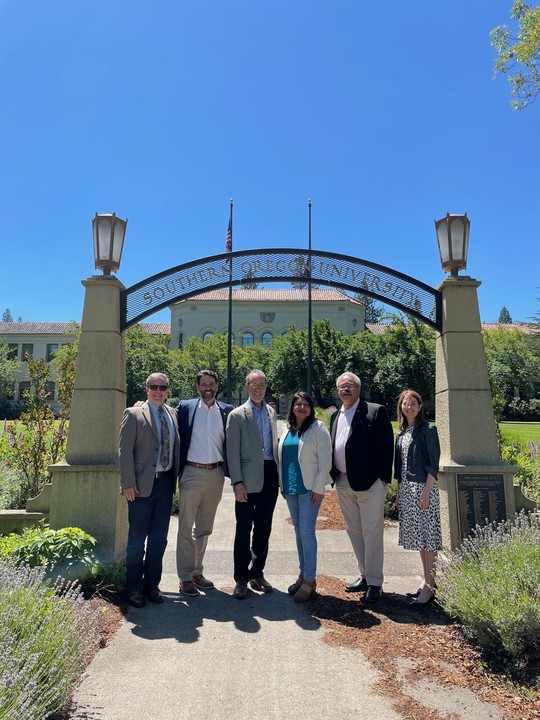
One Fabulous Program
An example of the kind of program that we need more of is Konaway Nika Tillicum (which means “All My Relations” in the Chinook Trade Language), an 8-day program that has taken place at Southern Oregon University for the past 25 years. It includes a broad range of classes, lectures, cultural experiences, and recreational activities for Native American students (grades 7-12), mainly students from Oregon but including some from other parts of the country.
We got to meet with them when we were visiting SOU. The counselors and instructors were all Native American, many of them former students in the program or even the children of former students. Students stay in SOU dorms and eat at The Hawk dining hall and experience life on a University campus. The program has had a lot of success in steering Native American students into higher education (a real accomplishment, given that this population has generally had very low levels of participation in post-secondary education).
I’m pleased to say that this wonderful program is being partially funded through the Summer Learning dollars that the Legislature appropriated.
You can read more about the Konaway program here.
During our visit we got to hear a traditional musical piece that the kids created and performed, using drums that they had made themselves. Here we are with them right after the performance:

Employment in Oregon Continues to Grow
Last week the Employment Department released the latest statewide unemployment rate and jobs numbers. Oregon’s strong labor market continued in June. The state had another month of solid job gains, and the unemployment rate remains near its all-time record low. In addition to the summary below, more details can be found in this news release and this video recap.
On the positive side, there are plenty of jobs out there for Oregonians. On the down side, many of the openings are going unfilled because there aren’t enough applicants with the necessary education, training, and skills.
Industry Highlights:
Several sectors had large job gains in June.
- Construction added 2,800 jobs over the month.
- Other services – which includes things like auto repair shops and hair salons – added 1,600 jobs.
- Leisure and hospitality and health care and social assistance each added 1,300 jobs over the month.
- No broad sectors of Oregon’s economy had large job losses in June.
Oregon has regained 94% of the pandemic recession job losses, compared with 98% for the U.S.
Oregon’s unemployment rate was essentially unchanged at 3.6% in June.
Oregon’s unemployment rate matched the nation’s.
- Oregon’s unemployment rate is near its record-low of 3.4% just before the pandemic recession.
- The labor force grew again in June, and more Oregonians found jobs.
- Oregon’s labor force participation rate ticked up to 63.6% in June, which was the highest since May 2012.
ON THE COVID FRONT
Weekly Data Report:
OHA didn’t produce a weekly report this week. We’ll get their next biweekly update next Wednesday. In the meantime, here is some high-level information that can help let us know where we appear to be headed here in Oregon. At the end of the newsletter you’ll find graphs that I’ve put together showing the daily counts and trends for the last two weeks.
Overall, infections, hospitalizations, and deaths have gone up somewhat in the last week, while test positivity has gone down. We appear to remain in the “COVID Crest” for now.
- The number of reported infections has plateaued. OHA reported 9,900 new cases of COVID-19 during the week of July 15-21 (vs. 9,955 the week before), a 7-day average of 1,414 per day (vs 1,422 the previous week). The number of new cases is again likely an undercount, as many people are using home tests to determine their infection status but are not reporting those results.
- Average test positivity for the last week was 13.9%, a slight reduction from the previous week’s 14.2%. Again, this number skews high because it likely reflects a higher proportion of people showing COVID symptoms (and thus going in for a test, rather than self-testing).
- On Thursday there were 423 COVID-19-related hospitalizations statewide, vs. 458 last Thursday. The number of hospitalizations appears to have peaked for now. Again, most of these hospitalizations are not in and of themselves due to COVID—they include those who tested positive after having been admitted for other reasons.
- Similarly, the number of COVID patients in Oregon’s ICUs was 45 on Thursday, a a sizeable drop from last week’s 63. These are the most serious COVID infections.
- There were 99 COVID-19-related deaths reported during the last week, vs. 58 last week. This big increase appears to be the result of some catching up of reports of deaths that occurred in the past. You’ll see that reflected in the two graphs at the end of the newsletter: the first graph shows the deaths as they are reported; the second shows the deaths as they actually occurred.
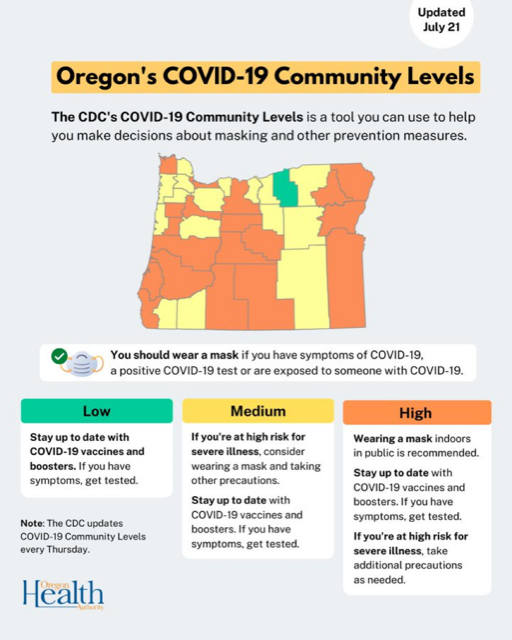 Weekly County Report: The Number of Counties at High Risk Down Slightly
OHA is no longer providing a weekly county report each Monday, but there are still ways to track this data. According to the CDC Daily Counter (updated each Thursday), 21 (down from 21 last week) Oregon counties are now at high risk of COVID transmission, a status that reflects both the number of new COVID cases and the number of people in hospital for COVID: Baker, Benton, Clatsop, Coos, Crook, Curry, Deschutes, Douglas, Jefferson, Klamath, Lake, Lane, Malheur, Marion, Multnomah, Polk, Union, Wallowa, and Wasco.
Here’s what the CDC recommends for this category: Stay up to date with COVID-19 vaccines. Get tested if you have symptoms. Wear a mask if you have symptoms, a positive test, or exposure to someone with COVID-19. Wear a mask on public transportation. You may choose to wear a mask at any time as an additional precaution to protect yourself and others. If you are at high risk for severe illness, consider wearing a mask indoors in public and taking additional precautions.
Sixteen Oregon counties (up from 12) have reported infection rates that place them in the Medium Risk category: Clackamas, Columbia, Gilliam, Grant, Harney, Hood River, Jackson, Josephine, Lincoln, Linn, Sherman, Tillamook, Umatilla, Washington, Wheeler, and Yamhill.
Only one Oregon county (down from 3)—Morrow—is now at Low Risk.
Again, we must remember that these are only the tests results that have been reported. With the prevalence of home tests, there are certainly many more positive cases out there that have not been reported.
We can also track the test positivity rates for each county at this dashboard. The test positivity rates reported this week show continued increases.
At 11.2%, Multnomah County shows a substantial reduction from last week’s 13.2%.
This Week’s Wastewater Monitoring Report Shows Continuing Improvement in Oregon Cities
With testing reports giving us just a fraction of infections out there, wastewater monitoring has become a more reliable indicator of the amount of virus in cities around the state. That report is updated each week.
This week’s report shows us that NO cities (down from 2) are showing sustained increases.
All cities surveyed are showing either no changes or decreases. This is what were expecting (and hoping for) from the projected “COVID Crest.”
OHSU Forecast: We Will Continue to Feel the Effects of New Variants
The current OHSU forecast report https: //www.ohsu.edu/sites/default/files/2022-07/OHSU-COVID-Forecast-July-21-2022.pdf published on Thursday, uses data provided by OHA and others that project how fast the virus may spread in the population and provides projections on possible outcomes, including infection rates and impacts on hospital capacity. The lead author is Dr. Peter Graven, Director of OHSU’s Office of Advanced Analytics.
It now appears every two weeks.
This week’s report confirms that the recent surge has peaked and is very slowly receding. Looking forward, the new forecast is similar to the one from two weeks ago.
Here are key observations in this week’s report:
- As of July 20, 424 people were in Oregon hospitals. The peak in the current wave, so far, was 464 on July 17.
- Wastewater data indicate a recent peak, with some declines in viral concentrations.
- Visits to Oregon emergency departments for COVID-like illness have fallen to 4.3% of all emergency visits. They peaked July 9 at 6.9%.
- Test positivity has dipped to 13.9% from 15.3% two weeks earlier.
- As of July 18, 10% of occupied ICU beds had COVID patients in them statewide. This is similar to two weeks earlier. While higher than normal, the numbers include people who were found to have COVID after entering the hospital for another reason.
- Ten children were in Oregon hospitals with COVID as of July 18, down from 16 two weeks ago.
- The forecast shows that the current wave has probably peaked. Infections and hospitalizations are expected to fall.
- We should see declining numbers of infections over the next 1-2 months.
- Some increase in deaths is still expected as the effects of the wave reach eight people a day.
- The effects on hospital staffing are likely to lessen over coming weeks as general infections decline.
- The model assumes that in general we will continue to see low levels of prevention from public policy or individual behavior.
Additional COVID Updates and Links
- COVID hospitalizations are going down, yet hospitals in the Northwest are finding themselves with few available beds. That’s because of staffing shortages, largely due to health professionals who test positive for COVID. Here's more.
- Second boosters are on hold for Americans under 50 as we await the broader vaccines promised for the fall. Here's why.
- Dr. Fauci has told Politico that he will be leaving his position with the White House with the end of President Biden’s current term.
- The Secretary of Health & Human Services announced on July 15 announced on July 15 that the U.S. remains in a Public Health Emergency.
- While the BA.5 variant is causing rising case numbers nationwide, public health officials say this is cause for caution, but not alarm.
- Some time ago I reported on the potential benefits of developing COVID vaccines that could be delivered nasally. How's that going?
-
A recent study reported in Nature suggests that immunocompromised people should change masks frequently to prevent microbial infection.
- The controversies around vaccinations and masking requirements have provoked conservative legal groups to aggressively take on public health mandates and the government agencies charged with protecting community health. They are having success.
- Thinking of going on a cruise at last? The CDC will continue to provide guidance for cruise companies, but it has ended its oversight program.
- For those of you with the medical science background to appreciate it, here’s a new paper from the Proceedings of the National Academy of Sciences (PNAS) on what it is about the structure of the Omicron virus that makes it so transmissible.
- Here’s a write-up by theOregonian’s Fedor Zarkhin of the recent briefing by Oregon State Epidemiologist Dr. Dean Sidelinger. He urges Oregonians to wear masks when they’re in indoor public spaces for now.
- You can also watch it here. And here are the talking points from the media briefing, which also includes information about the new Novovax vaccine and the Monkeypox outbreak.
-
Fortune reports on a U.S. House hearing on the effects of Long COVID on American workers.
- And on the same note, here’s an article from the Oregon Capital Chronicle on the effect of Long COVID on roughly 280,000 Oregonians.
- Here’s the latest from the Capital Chronicle on the impact of Long COVID and Monkeypox on Oregon’s hospitals.
- President Biden finally succumbed to a COVID infection this week. He seems to be doing well overall, thanks to vaccinations and improved treatment. Here's how his experience compares with President Trump's experience with COVID.
- Have you managed to avoid COVID so far? (I THINK I have.) If so, you’re part of an increasingly exclusive club: The COVID Super-Dodgers!!!!
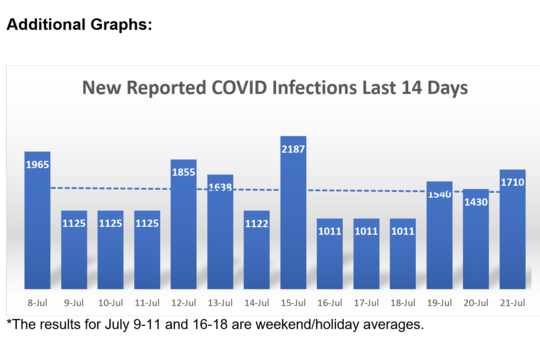

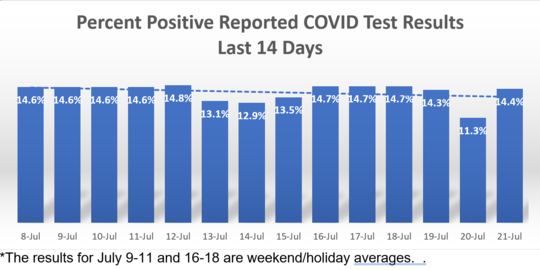
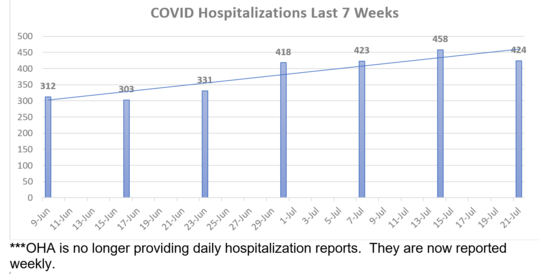
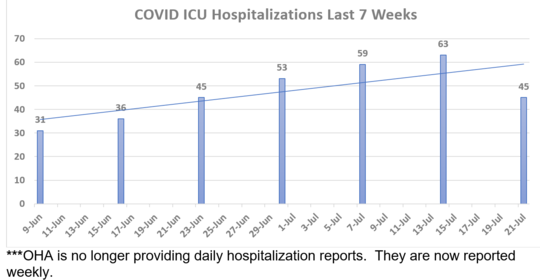



Here again are some COVID resources that you will find useful:
If the above links are not providing you with answers to your questions or directing you to the help that you need, please consider me and my office to be a resource. We’ll do our best to assist you or steer you in the right direction.
Want to See Past Newsletters?
If there was COVID-related information in a past newsletter that you want to go back to, but find you’ve deleted it, you can always go to my legislative website (senatordembrow.com), click on “News and Information,” and you’ll find them all there. Also, if someone forwarded you this newsletter and you’d like to get it directly, you can sign up for it there.
Best,
 Senator Michael Dembrow
District 23
email: Sen.MichaelDembrow@oregonlegislature.gov
web: www.senatordembrow.com
phone: 503-281-0608
mail: 900 Court St NE, S-407, Salem, OR, 97301
|